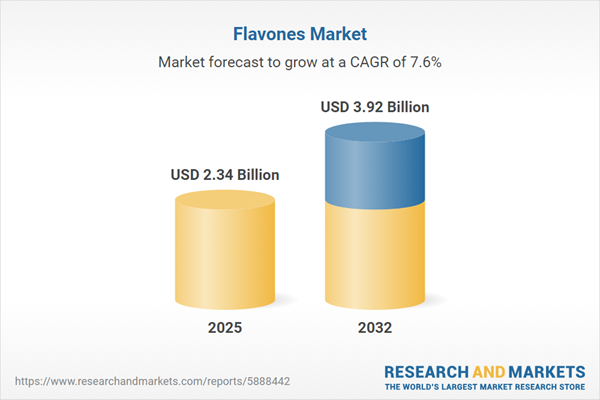Speak directly to the analyst to clarify any post sales queries you may have.
Senior leaders in the flavones market face a complex landscape where regulatory shifts, technological innovation, and evolving client priorities require agile strategies and operational flexibility. Driving sustainable value demands a clear understanding of current market trends and actionable insights for long-term growth and resilience.
Market Snapshot: Flavones Market Growth and Trajectory
The global flavones market is advancing rapidly, recording expansion from USD 2.18 billion in 2024 to USD 2.34 billion in 2025, and is set to reach USD 3.92 billion by 2032. This upward momentum reflects surging demand from nutraceuticals, cosmetics, food, and pharmaceutical segments. As organizations respond to rising wellness trends, advanced extraction techniques and optimized formulation processes empower leaders to stay ahead of shifting market demands. Competitive pressure is fueling rapid innovation and increased investment in research, as market players enhance relevance through strategic agility and excellence in supply chain operations.
Scope & Segmentation: Comprehensive Market Landscape
- Type: Key product categories include apigenin, baicalin, chrysin, diosmetin, luteolin, and tangeretin. Each type supports distinct application needs, allowing organizations to offer customized solutions that address precise client health or functional objectives in the business-to-business space.
- Source: Incorporating both natural and synthetic flavones helps firms support clean-label initiatives and strengthen supply-chain resilience. This dual approach assists in navigating shifts in global sourcing requirements and aligning product lines with corporate sustainability or regulatory strategies.
- Application: Utilization spans cosmetics, food and beverage, nutraceuticals, and pharmaceuticals. Broadening application scope provides manufacturers with opportunities to diversify portfolios and tap into emerging high-growth market segments worldwide.
- Formulation: Offering flavones in capsules, liquids, powders, and tablets delivers product adaptability. This flexibility supports access to geographically diverse B2B buyers, with region-specific and industry-tailored options improving market penetration.
- Extraction Method: The use of enzymatic, solvent-based, and supercritical CO2 extraction methods enables scalable production, supports company sustainability objectives, and ensures adherence to evolving quality benchmarks.
- Distribution Channel: Deploying direct sales, online platforms, and retail partnerships allows companies to widen global reach, streamline delivery, and enhance commercial client acquisition and retention in the flavones market.
- Regional Coverage: The market operates across the Americas, Europe, Middle East & Africa, and Asia-Pacific. China, India, and Japan are highlighted for regulatory advancements and rising health awareness, contributing to expanded adoption of flavone-derived products.
- Leading Companies: Influential players such as BASF SE, Koninklijke DSM N.V., Givaudan S.A., International Flavors & Fragrances Inc., Indena S.p.A., Martin Bauer GmbH, Euromed S.A., Zhejiang NHU Company Limited, Hunan Nutramax Inc., and Xi’an Sgonek Health Industry Co., Ltd. shape sector dynamics through product innovation, global scale, and resilient supply chains.
Key Takeaways: Strategic Insights for Senior Decision-Makers
- Adoption of innovative extraction technologies advances sustainability targets and elevates process efficiency, aligning corporate practices with demanding international benchmarks for quality and environmental impact.
- Maintaining flexibility in sourcing strategies, by balancing natural and synthetic flavone inputs, equips businesses to navigate supply chain disruptions and regulatory changes with greater agility.
- Expanding focus on cosmetics and nutraceutical applications positions organizations to benefit from increasing consumer interest in wellness and functional ingredients worldwide.
- Collaboration among research, development, and formulation teams accelerates product delivery, driving responsiveness to evolving commercial opportunities and customer requirements.
- Employing diverse distribution strategies, including digital commerce and in-market partnerships, enables real-time adaptation to shifting buyer preferences and optimizes access to broader B2B segments.
- Continuous monitoring of regional policy frameworks strengthens the capability of firms to adjust strategies as local and global market conditions shift, helping secure long-term competitive positioning.
Tariff Impact: Adjusting to Regulatory Changes
US-imposed tariffs have reconfigured international flavones supply chains. Manufacturers in Asia and Europe have responded by shifting to offshore processing to maintain effectiveness, while US-based firms are establishing domestic collaborations to deliver added value. Implementing adaptable sourcing policies and agile procurement systems remains critical in managing regulatory and trade uncertainties, thereby protecting business continuity and sustaining client relationships in a changing global landscape.
Methodology & Data Sources
This research integrates input from industry stakeholder interviews, expert panels, proprietary databases, and peer-reviewed references. Combining in-depth qualitative perspectives and quantitative analysis provides senior decision-makers with robust evidence to support strategic planning in the flavones market.
Why This Report Matters: Benefits for Senior Leaders
- Thorough segmentation insights empower leadership to drive informed choices on strategy, market entry, and portfolio evolution in the flavones sector.
- Guidance on emerging regulatory and technological shifts enables the development of future-ready business operations and more effective capital deployment.
- Scenario-based benchmarking equips executive teams to proactively manage risk and respond confidently to fluctuating industry environments.
Conclusion
By combining rigorous market intelligence and operational adaptability, leaders in the flavones industry can anticipate market transitions, capture new growth avenues, and sustain robust business performance amid ongoing market evolution.
Additional Product Information:
- Purchase of this report includes 1 year online access with quarterly updates.
- This report can be updated on request. Please contact our Customer Experience team using the Ask a Question widget on our website.
Table of Contents
3. Executive Summary
4. Market Overview
7. Cumulative Impact of Artificial Intelligence 2025
Companies Mentioned
The companies profiled in this Flavones market report include:- BASF SE
- Koninklijke DSM N.V.
- Givaudan S.A.
- International Flavors & Fragrances Inc.
- Indena S.p.A.
- Martin Bauer GmbH
- Euromed S.A.
- Zhejiang NHU Company Limited
- Hunan Nutramax Inc.
- Xi'an Sgonek Health Industry Co., Ltd.
Table Information
| Report Attribute | Details |
|---|---|
| No. of Pages | 189 |
| Published | November 2025 |
| Forecast Period | 2025 - 2032 |
| Estimated Market Value ( USD | $ 2.34 Billion |
| Forecasted Market Value ( USD | $ 3.92 Billion |
| Compound Annual Growth Rate | 7.5% |
| Regions Covered | Global |
| No. of Companies Mentioned | 11 |









